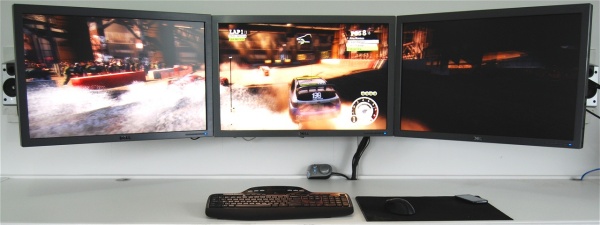Final Thoughts
When it comes to triple monitor performance we feel the battle between the Radeon HD 6990 and GeForce GTX 590 reaches a similar conclusion to that of a single high-res screen. Each graphics card has its ups and downs depending on the game, but on average they tend to deliver roughly the same performance. The exception to this trend was seen at 7680x1600, where performance was often compromised but the Radeon HD 6990 was usually the better performing board.
Graphics setting adjustments have always had an impact on the performance margins between AMD and Nvidia cards, but the degree of that effect is amplified at these extreme resolutions. Simply pushing the anti-aliasing level one notch too high was enough to see the GeForce GTX 590 go from playable to a complete slideshow.
As is the nature of dual-GPU graphics cards, they sometimes suffer from the lack of multi-GPU support in certain titles. For the GeForce GTX 590 it was Dragon Age II where things went badly, while the Radeon HD 6990 fell apart in Crysis 2. There were a few select games where both cards delivered similar performance such as Bulletstorm, Crysis Warhead, Civilization V, Far Cry 2 and Metro 2033.

Those wanting to play at 5760x1200, which generally requires three 24" or 27" monitors will find the performance of a single Radeon HD 6990 or GeForce GTX 590 acceptable in most games unless you are really picky like myself, as I prefer to have an average of 60fps in first person shooters. If that's the case you will be disappointed to hear that even when running these expensive dual-GPU monsters, uber-smooth gameplay is not as easy to achieve when running triple monitors.
This is where things get a hell of a lot more complex and expensive. A single Radeon HD 6990 or GeForce GTX 590 plus the three 30" LCD's alone will set a gamer with deep pockets back more than $5000, so the thought of buying a second $700 graphics card probably won't see them bat an eyelid.
A few more notes on triple monitor gaming setups... We applaud the ease in which it is possible to setup multiple-monitor configurations. Both AMD and Nvidia have excellent setup procedures and we ran into no real problems when configuring the Dell monitors.
On the negative side, most games will have aspect ratio problems with multiple screen configurations and those that don't will likely need you to fine-tune the FOV (Field of View) setting. Another annoying issue which is very difficult to overcome in most games is stretched screens which lead to a fish eyed view of the game from the side screens.
Therefore it's my opinion that triple monitor gaming doesn't make a whole lot of sense for those with smaller monitors. I believe gamers are better served going from a 22" monitor to a 24" or 27" monitor rather than purchasing more 22" monitors. As we ask around we hear from a lot of people that simply love the experience while many others wouldn't bother to give this a try. How about yourself?